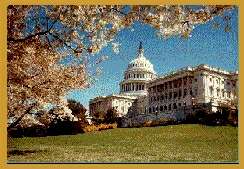CHAPTER 3 : CONGRESS
3.0 Introduction
The opening words of Article I of the Constitution
states:
"All
legislative power herein granted shall be vested in a Congress."
Congress was thus established as the central organ
in the national government. It was vested with supreme authority.
As Earnest Griffith puts it, Congress is still regarded by many
as "the world’s best hope of representative government."
The Congress of the United States in the bicameral
legislative branch of the nation. It consists of two branches:
the Senate, and the House of Representatives. The
composition of the Senate is fixed by the Constitution. It
is composed of 100 members; two senators from each of the 50 states.
The term of senators is six years; one-third of them retiring
every two years. The composition of the House is determined by statute.
It is composed of 435 members divided among the states according
to population. The term of representatives is two years.
The idea behind having the voters directly elect
the members of the House for a short term, was that it could cater
to the immediate concerns of the people. In contrast to this, the
Senate was chosen to be a reflective body that would consider the
interests of the people in the longer term. Until 1913, senators
were chosen by the state legislatures. But then according to the
Seventeenth Amendment, the senators were chosen by direct election.

Exhibit 3.1
The Capitol
|
Index
3.0
Introduction
3.1 Powers of Congress
3.2 The Organization of Congress 3.3
How a Bill becomes a Law
Chapter
4
|